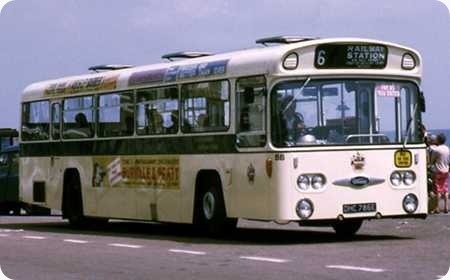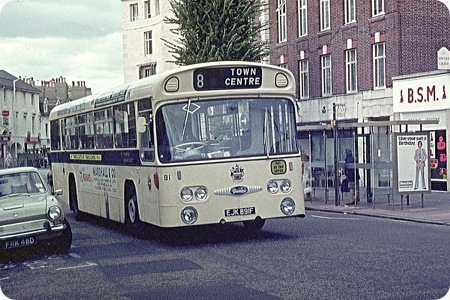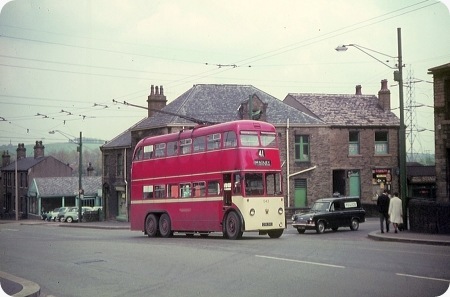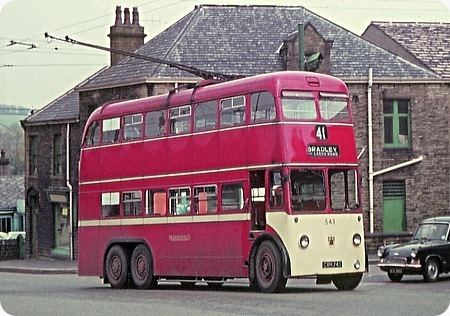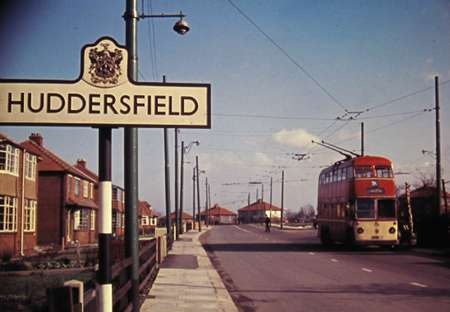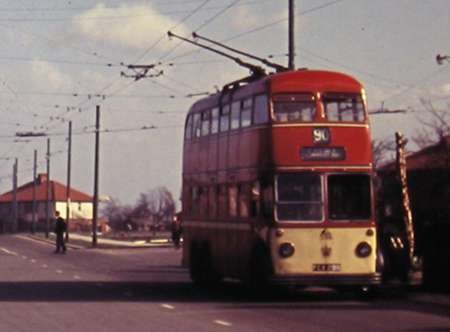Eastbourne Corporation – Daimler Roadliner – DHC 786E – 86
Eastbourne Corporation
1967
Daimler Roadliner SRC6
East Lancs B45D
Here is a shot of the Eastbourne Roadliner, that Diesel Dave referred to under the Halifax Corporation – Daimler Roadliner on the 4th of January heading. Cummins earned such a bad reputation for its V6 engine (and the corresponding V8) that it is a wonder that it survived as a company. For years, Cummins used its own fuel injection system in which the pump pressurised the fuel lines but the injectors were individually actuated by a separate camshaft. It is rumoured that Cummins devised this system to avoid paying royalties to the inventors of the in line fuel pump, the German Robert Bosch company. In Britain, Lucas/CAV manufactured pumps under Bosch licence. The Cummins system rendered the engine unresponsive to modest movements of the accelerator – the engine was either "on" or "off". I never drove a Roadliner, but I have driven Lynxes and Olympians powered by the later L10 engine, and they were crude and rough. Proper fine control of the engine was impossible. The present day "B" series engine and its derivatives used in ADL buses was originally a design of the Case Corporation, and does not have the traditional extreme Cummins characteristics.
Photograph and Copy contributed by Roger Cox
———
22/03/12 – 08:16
I think Cummins survived (at least in Britain) because the passenger and freight markets don’t talk to each other much. The V engines may have been as bad in both, but Cummins were also building inline engines which seem to have been very successful, and which marked the beginning of the end of Gardner supremacy in ERF and Atkinson trucks among others.
What I find more surprising is the way the bus industry embraced the L10 after its earlier bad experiences.
Peter Williamson
———
22/03/12 – 13:41
Cummins came badly unstuck with some diesel-powered trains a few years ago, with them having to replace the unreliable engines at some cost to themselves.
Chris Hebbron
———
22/03/12 – 13:41
Many examples can be found where British companies made the best product in the world and then just sat back and allowed the rest to catch up. When the power to weight legislation came in the six cylinder inline Cummins did become popular with ERF and Atkinson buyers in the haulage sector, but it was more a case of supply rather than choice. The Cummins was more readily available than the Gardner, but it wasn’t as reliable and devoured fuel at an alarming rate. Gardner did have a ‘240’ inline eight cylinder marine engine that was very reliable for the job it was designed for but as a vehicle engine it wasn’t, but in fairness it was being asked to do a job for which it was never intended, marine engines tend to work for long periods at more or less a constant RPM, where as the RPM on a vehicle is constantly fluctuating, it gained a reputation as being unreliable. Gardner tried fitting a turbo to the 180, but through complacency they eventually fell victim to the classic British motor vehicle disease of failure to invest in development
Ronnie Hoye
———
22/03/12 – 13:42
Whatever merits the L10 may have had as a lorry engine, and one can but reflect upon such "merits" in the ultimate fates of ERF and Seddon Atkinson, it was not a good bus engine, having crude response to accelerator pressure resulting in very rough and jerky ride standards. Along with the Seddon Pennine IV, I would nominate the Cummins powered Lynx as the most horrible vehicle type that I have ever driven. Likewise, the Cummins Olympian was not a patch upon the sophistication of its Gardner equivalent. The L10 was enlarged into the 10.8 litre M11, and early tests with this engine proved that it was totally unsuitable for bus work. It is noteworthy that, along with ERF and Seddon Atkinson, the M11 has now virtually disappeared from the road haulage scene. The smaller "B" series used initially in the Dart and later in ADL ‘deckers as well is a much superior design.
Roger Cox
———
23/03/12 – 06:30
Rolls-Royce made the Eagle Diesel engine for lorries, which was not too good, and metamophosed into a Cummins engine on takeover, in the end, also not very good, I believe. Was the Eagle ever fitted into buses. I believe it was rather large.
Chris Hebbron
———
23/03/12 – 06:30
I am surprised at the comments about the Cummins L10 engine. My fleet took a batch of L10 powered Olympians which I viewed with some trepidation. However they matched the 6LX engined Fleetlines they replaced almost exactly in fuel consumption despite having rather more go about them. After an initial problem with cylinder head gasket failures (quickly modified and repaired by Cummins) reliability was exemplary and they were a delightfully simple to work on. Very different from their successor vehicles fitted with the Swedish engine – needed a fuel tanker to follow them round each day and not nice to work on. As for drivers’ comments about the L10, well there was nearly an international enquiry each time one of the fleet worked from the main depot after any repair work had been completed. The ones they couldn’t stand were some early Gardner Olympians with Voith transmission. The comment about replacing engines in diesel trains, I’m pretty sure this referred to trains built with MTU power units as the Cummins NT14 had given excellent service in BR built trains.
Looking at the photo of the Eastbourne bus I am struck that it would not look out of place amongst todays single deckers. It looks smart (the livery helps there), modern, well proportioned and purposeful. What a pity the Roadliner didn’t succeed as the concept was excellent. Still, neither AEC nor Leyland fared much better with early rear engined single deckers.
Ian Wild
———
23/03/12 – 07:14
SYPTE specified Rolls Royce Eagles to special order for all their Dennis Dominators and all their MCW Metrobuses. This only ended when they began a period of single deck purchase and operation with the Volvo B10M Alexander PS era. One must therefore assume that they were happy with their Eagles – which all had full service lives.
Roll Royce (Eagle) engines were bought by Perkins – not Cummins. (I believe they eventually, by a series of buy outs, ended up in common ownership – but the Eagle became a Perkins).
David Oldfield
———
23/03/12 – 09:35
Thx, David.
Chris Hebbron
———
24/03/12 – 09:19
From what I remember reading at the time, I’m pretty sure the Cummins L10 was designed specifically as a bus engine, and wasn’t used in lorries.
As for the Rolls Royce Eagle, I’ve heard exactly the same about that as Ronnie says about the 8-cylinder Gardner – that it was designed for marine use and wasn’t much good on the road. SYPTE chose it for extra muscle, which they felt they needed, and that being the case, they probably felt they had no choice but to stick with it. With the number they had, they would at least become world leaders in making it work!
Bristol Omnibus also used five or six Rolls-Royce powered Metrobuses in Bath. Anyone familiar with Bath and Sheffield will quickly see the connection!
Peter Williamson
———
24/03/12 – 09:20
Referring to Roger’s comments, the most difficult things I ever had to drive were a couple of ex Shearing’s L10, ZF manual Leyland Tigers. I always put it down to the clutch not being man enough for the job, but maybe I was wrong. Rogers comment about crude response to accelerator pressure producing a rough, jerky ride certainly rings true. Taming the beast was a challenge and then rejoicing when you got the knack! [One of my favourites was a ZF manual Tiger with TL11(260) engine.]
Not really experienced in the engineering or operating side, the number of negative comments on the L10 comes as a surprise. I have driven M11 powered Dennis Rs with AS-tronic – including a jaunt to the south of France – and found it most enjoyable experience. [I have known one vehicle for about six years. The engine has never given cause for concern.]
David Oldfield
———
24/03/12 – 18:08
The Gardner 240 bhp 8LXB was widely and successfully used in lorries; its problem was that it was physically large and very expensive. The 6LXB/C/D, even in turbocharged form, increasingly became unable to meet minimum power to weight requirements in the the haulage market. To compound the problem, British lorry manufacturers always charged a premium over and above the extra cost for Gardner- in his "Gardner" book, Graham Edge illustrates that the extra cost for a Gardner 8LXB of £1367 became a mark up of £3000 in the ERF sale price. In the straitened economic circumstances of the 1980s, the much cheaper Cummins L10, which was certainly widely installed as standard in Seddon Atkinson, Foden and ERF chassis, became the preferred option. I am not challenging the reliability or fuel economy characteristics of the Cummins, but I do hold fast on its unsatisfactory throttle response features. The Wikipedia entry on the Roadliner says, "The Cummins V6 had that manufacturer’s patented intermediate-pressure fuel pump and governor system, supplying the fuel to open-cup injectors through internal drilled fuel galleries, four-valve cylinder heads and tappet-actuated injection. This made the engine less than suitable for slow speed stop-start work……". The same characteristics were carried over into the L10.
Taking up Ian Wild’s point about a certain "Swedish" ‘decker engine, the two Gardner Olympians outstationed at Ramsey in the Huntingdonshire Fens could complete two days if required on a tank of fuel. The Volvo Olympians that replaced them not only drank fuel at a prodigious rate, but were equipped with smaller tanks, and had to be filled up twice in the same day. They also possessed the endearing characteristic of blowing out all the power steering fluid. With the Voith three speed transmission, which required the engine to scream up to near maximum revs in the lower two gears before changing up, they were, in my view, despite their powerful performance, decidedly less than impressive. I have also driven TL11 powered Olympians, which were smooth, civilised machines. Given a more enlightened political approach at the time, the TL11 had development potential that could have been reflected in a much stronger present day British engineering industrial base.
Roger Cox
———
25/03/12 – 09:07
Rolls Royce engines in trains (Bedford – St Pancras DMUs circa 1960) were a disaster, having an unfortunate propensity to ignite spontaneously. In the mid 1980s British Rail insisted on dual sourcing for the big class 158 fleet, so that some were fitted with Perkins engines, which proved inferior to the Cummins unit. (I think they may also have been fitted in some of the class 165s for the same reason, and with no better results.)
Stephen Ford
———
25/03/12 – 09:08
Being an enthusiast rather than an engineer, I have found Roger’s insight of the operational drawbacks of the Cummins L10 quite fascinating. Wasn’t this the standard engine fitted to the MCW Metroliner 3 axle double deck coaches new in the early/mid eighties?
Bob Gell
———
25/03/12 – 18:55
On the subject of reliability, a survey taken in 1979 by "Transport Engineer", the journal of the Institute of Road Transport Engineers investigated the maintenance costs of 9488 heavy lorries, fitted with 16 different engine types, operating at 30/32 tons gvw. This entirely independent review showed the 6LXB at the top of the list, costing just 0.265 pence per mile to maintain, with the 8LXB in close second place. This survey predated the introduction of the Cummins L10, which appeared in 1982, but the earlier Cummins straight six ranges occupied third and sixth places in the list, very creditable indeed. Doubtlessly the later L10 would have returned similar figures. Interestingly, the Leyland O680 and 510 came fourteenth and fifteenth respectively, just above Scania, the costs for which were six times those of the 6LXB. One can only reflect upon the figures for contemporary engines, with their high turbocharging pressures and costly emission control systems, together with their propensity to drink fuel like a dipsomaniac.
Roger Cox
———
30/03/12 – 07:05
I recall from my days on Southdown just after it’s sale to Stagecoach one of our depot fitters being less than impressed by the Gardner engines lack of oil tightness when fitted to a batch of recently delivered Olympians when compared to the Volvo D10M’s bought by the independent Southdown. He said you could get to work almost straight away on the Volvo when necessary with only a minimum of cleaning, whereas the Gardner took some time to get clean enough to work on.
Diesel Dave
Quick links to the - Comments Page - Contact Page - Home Page
